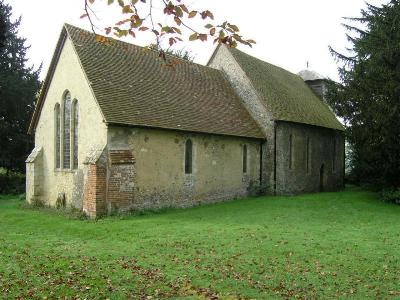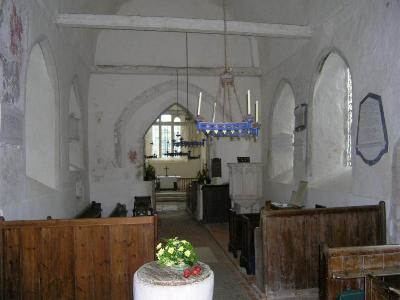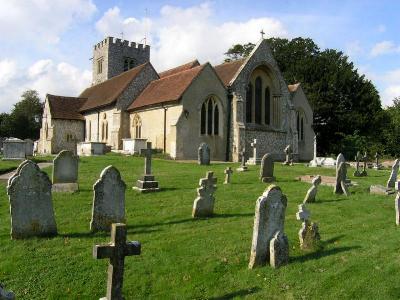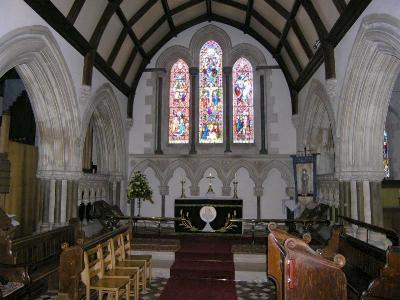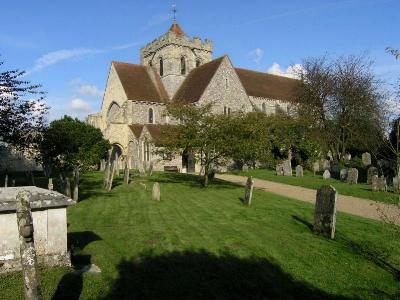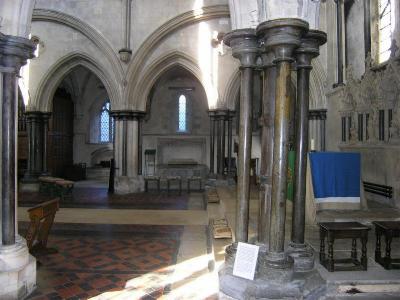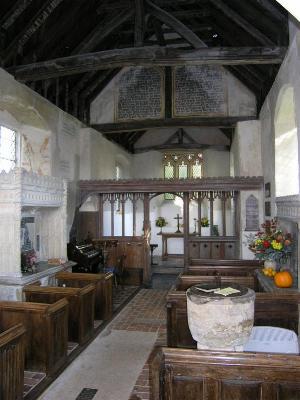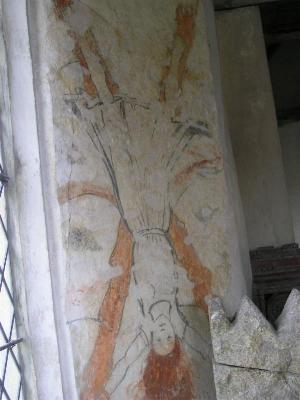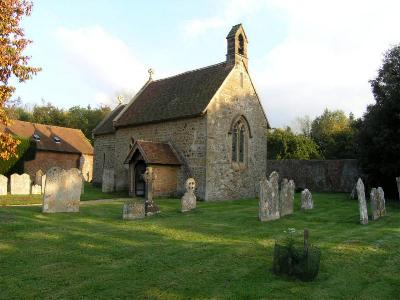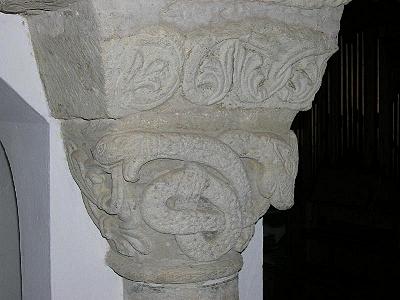
A trip to West Sussex
The 16th October, a Monday morning and
I got up early as I had an appointment with a fellow
ChurchCrawler Tom in Sussex. Why can't I get up and out of the
house like this when I go to work? I was heading for the M4 at
Bath by 0750, and the weather seemed set fair. High up near
Bath and again at Hungerford there was fog, but not too bad. I
plunged south to Winchester, turned off the A34 towards
Petersfield and drove in the clouds or so it seemed. Signposts
suddenly appeared, as did bends in the road, which if it were not
for my electronic mate Tim navigating may have been more of
a surprise. Rendezvous point South Harting at 1030, I got there
at 1001.
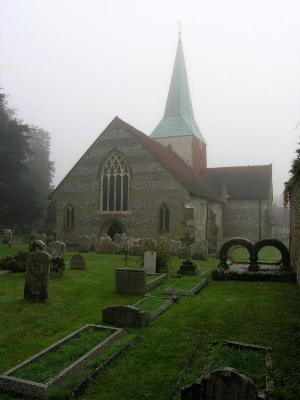 |
St Mary & St Gabriel,
SOUTH HARTING The
church emerged from the mists as I got near to the top of
the little High Street. This is supposed to be in the
South Downs, a group of hills, but I had not yet seen a
hill. I was to discover is a large church by local
standards. The fog swirled around the apex of the
crossing steeple which oddly has a tiled south face. On
this side too ruins of a chapel. Cobwebs were picked out
clearly by the water droplets in the mist.
The interior was rather gloomy
- the fog wasn't helping here either - but the
chancel perverseley seemed to be better lit and has
the most amazing Elizabethan roof. Also of note is the
Victorian spiral staircase in the north transept which
hopefully will not be swept away in the plans which the
parish have for meeting rooms etc. although this
extension will be in the most prominent of positions
externally, facing towards the top of the High Street.
|
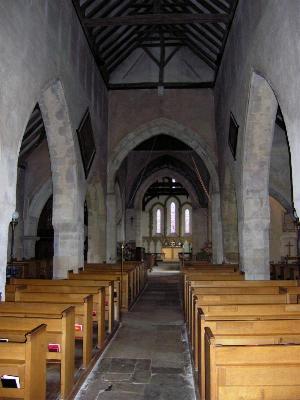 |
The monuments in the south
transept hint of former splendour as well as a previous
setting for all. None seem to be in theri original format
and a couple seem to have been outside at some stage -
perhaps in the chapel. Tom
arrived at 1014 and we were then greeted (or
made to jump) by the loud bongs on
the bells by the clock striking the quarter-hour. I liked
his approach as we did not linger as I had "seen it
all". I left my car outside for the day as Tom
guided me to his personal choice of splendours for the
day which I was to adjust ever so slightly. He also knew
of a childhood ambition I needed to satisfy.......
|
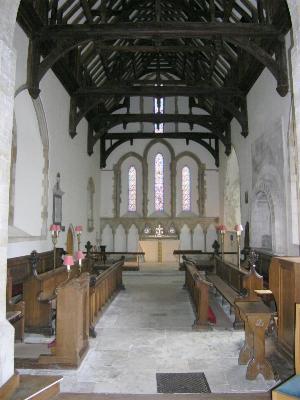 |
St Mary, NORTH
MARDEN
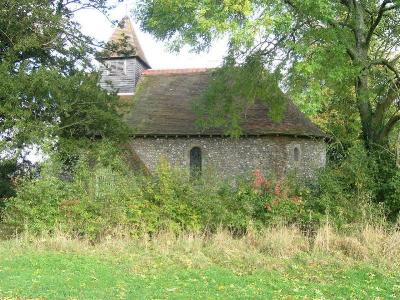 |
has to be the antithesis of
Harting, a Norman single cell building with
rounded end, a south porch and a small
bell turret. It has an ugly farmyard for company and a
narrow path to the churchyard which was very cobwebby for
someone of my height. |
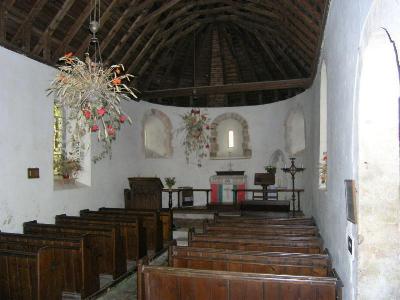 |
And that is it, probably
much restored details-wise, and the only addition being the
overlarge C13 piscina which breaks up the rhythm of the apse. Sounds
dull, well yes it is dull as architecture, but this was to
be a day of feelings, emotion, as these churches get
"under the skin". This was really the first of many.
St Michael, UP MARDEN
is much larger, and a
building which seems to have something from every time despite
being nearly entirely C13. I am not making sense I feel, but
that's just it - the church feels organic, unrestored - yet it
has been restored but when needed rather than all at once,
repaired, made do and mend. It appears to have a bell turret at
the west end of the nave - but no, this is the remains of an
actual west tower, or a tower which was never finished.
Inside all is whitened and there
is a sense of just having enough seating for what is required,
the benches arranged in all sorts of order, a pew here a bench
there a chair here - nothing really matches. A faded St
Christopher can be seen on the north wall, and there is a jarring
Victorian stone Perp pulpit, jarring in its perfectness rather
than not fitting in here. Then there is the biggest puzzle, the
failing pointed chancel arch has been reinforced by partly
filling in with a Saxon chancel arch........the explanation seems
to be that it came from the demolished church at West Marden,
already disused in the late C16. No stained glass, no
electricity, but lots of flowers. And outside the mists were
beginning to clear.
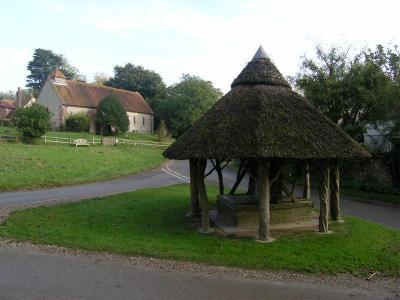 |
St Peter, EAST MARDEN is everything that Up Marden is not
i.e. restored, gone over, and rather anaethestised.
Pretty setting, a long single cell EE church which did
not detain us long. The best bit is the Organ, from St
James Palace and reputedly much played by Prince Albert.
The picture also shows the
village well, making a nice group with the church.
|
St Mary, STOUGHTON
appeared to be back in
the fog but was actually being covered like we were when
we approached with choking smoke from the neighbouring
garden's bonfire. The church was locked but according to
the apologetic sign only because of rewiring in progress
- workmen nowhere to be seen though! This looked
interesting from outside so it was a disappointment for
me and I mentally added it to a list to revisit.
We adjourned to the
village pub for lunch. The food was not the usual fayre,
and was enjoyed by us both along with some excellent ale.
|
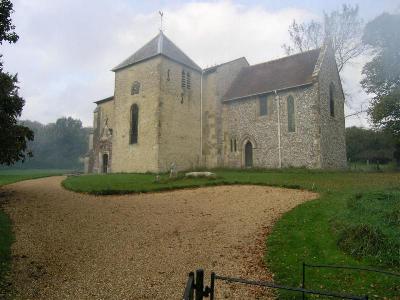 |
St Mary, FUNTINGDON
was not on Tom's itinary but I
persuaded him to stop! Here too is a large medieval church
heavily restored by the Victorians, but with real aplomb! It is
sad the architect is not recorded as the chancel and its
arcades are high quality work. The glass too in the east
triple lancets is wonderful quality work of (d)1865. Part of the
north aisle is currently demolished as the village is building a
complex of community rooms onto the western end of the aisle.
St Andrew, WEST STOKE
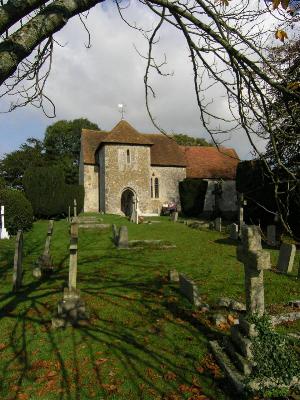 |
is uncommonly photogenic,
consisting of a nave and lower chancel with low south
porch tower, all rather restored sadly but with the most
splendid and touching "kneelers" monument
of 1635. Husband (Adrian Stoughton) and wife kneel facing
each other with a family group below. They had 16
children, two sons and five daughters are shown and named
below, four of the girls carrying skulls showing they
pre-deceased the parents. The remaining children died in
infancy meaning only the two sons and one daughter
survived the parents. |
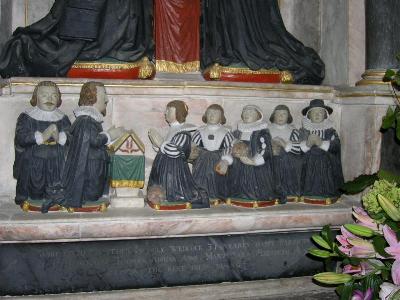 |
Priory Church of St Mary & St
Blaise, BOXGROVE
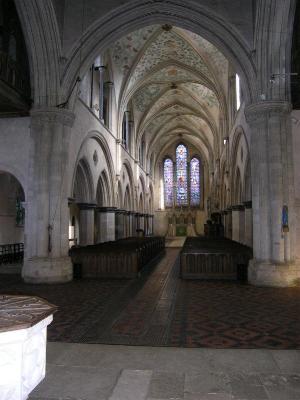 |
has been on my list to visit
for over 40 years and it did not disappoint. The first
thing you see is the gaunt ruin of the Guest House, which
along with the frontageentrance to the vanished chapter
house is the only remaining parts of the domestic
buildings. The large (for Sussex) priory church has
lost most of its Norman nave and S aisle, but the
north wall of the nave with blank arcade and much of the
south arcade still stands. What survives as the church in
use today is the east two bays of the nave and aisle, the
crossing, transepts and the sensational EE choir and
aisles. It is in fact smaller than it appeared in photos
to me and is close to prefection in my eyes. I could have
spent two hours here easily - perhaps we were here an
hour or so, Tom waiting patiently as I adsorbed the
building into my mind. |
| St Mary, UP WALTHAM 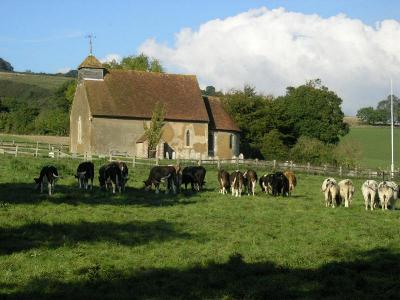
|
In a day of contrasts it was a
return to the humble for the next church. It stands in a
field, probably Norman, nave and lower apsidal chancel,
south porch. Again zero architecture but great
atmosphere. Flowers everywhere, and sadly (?) now with
electricity; Nairn - BoE - found only candles. Just
installed this year in September (to much fanfare in the
porch) the Millenium Window at the west end of nave, Tom
and I agreed that whatever it cost it was a disappointing
result. Largely plain glass with some butterflies,
swallows and flower transfers stuck on (or that's how it
appeared). I forget the artist, she is unlikely to get a
commission from us I can tell you though! I liked the
piscina in the apse, a hollowed-out Norman capital. |
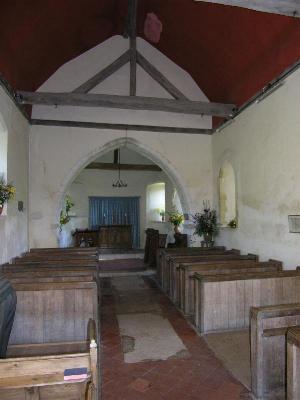 |
Church (Dedication Unknown),BURTON
Three major monuments, two with
brasses under canopies, the third with a diminutive effigy of
a LADY (I came over all "Little Britain"
then......sorry). On the window splay behind the monument on the
north wall is a wall painting showing a female martyr crucified
upside down; the wall opposite has a large mural of the Royal
Arms of Charles 1st 1636. Perp screen, painted tympanum and
all seemingly unrestored.
St James, SELHAM
a late Saxon, early Norman
two-celled church with a later transeptal south chapel rebuilt as
a Victorian aisle. Despite this age there is little of interest -
EXCEPT that is for the chancel arch. I felt his must surely have
come from elsewhere - Chichester? But it seems not. It has two
absurdly large and over-ornamented Saxon capitals, that on the
south with serpents treated like interlace work.
St Andrew, DIDLING
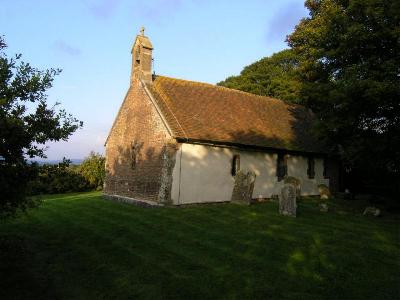 |
With light beginning to fail
we hurtled onwards to reach Tom's last
intended target. Against the escarpment of the South
Downs, this is another church which seems to have just
evolved. The recent repainting of the exterior is a
little harsh but step inside and the church embraces the
senses. (And yes smell too, thanks to the Harvest loaves
still on display!). The pews are stained black, but parts
must be C13. Ancient roof beams and battered font (filled
with water!) contrast with the more upmarket Communion
Rails and three sided Jacobean pulpit. |
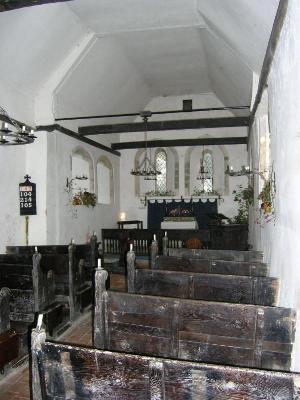 |
Back to South Harting and I could
see the hills! 12 churches, 11 open, the 12th shut with regret.
A knowledgable and entertaining guide too made the day, and
two new churches for Tom too was I hope some reward for his kind
guidance and transportation.


page created 27th
October 2005






